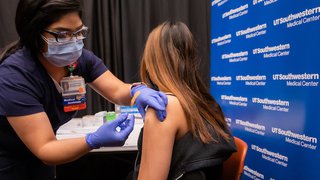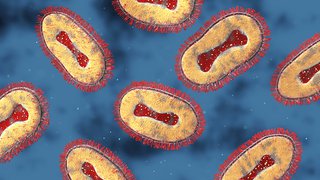COVID-19: What you need to know and how to reduce the risk of infection
February 3, 2020

EDITOR'S NOTE: This article was published Feb. 3, 2020, and updated on March 15. The COVID-19 situation is rapidly evolving. For updates, please go to our COVID-19 website.
Until a few months ago, few people outside the medical or scientific communities had ever heard the word coronavirus.
Since December, however, it has captured the world's attention and increasingly has become the focus of our daily lives.
As the pandemic continues to spread in the U.S. and North Texas, patients should know the facts about the disease, now named COVID-19, and basic ways they can help prevent its spread.
Coronavirus facts, symptoms, and origins
A coronavirus is a family of respiratory viruses that can spread quickly from person to person. The main form of transmission is primarily by respiratory droplets expelled through coughing and sneezing.
On Feb. 11, 2020, the International Committee on Taxonomy of Viruses, charged with naming new viruses, named the novel coronavirus “severe acute respiratory syndrome coronavirus 2,” shortened to SARS-CoV-2. The World Health Organization (WHO) announced the official name for the disease coronavirus disease 2019, abbreviated as COVID-19.
SARS-CoV-2 is the virus that causes COVID-19, the disease.
There are multiple types of human coronaviruses, including some that cause mild upper-respiratory tract illnesses. COVID-19 is a new disease, or novel coronavirus, that has not previously been seen in humans.
The first infections were linked to a live animal market in Wuhan, China. The virus is now spreading from human-to-human and has spread to multiple countries, including the U.S. Someone who is actively sick with COVID-19 can spread the illness to others, usually through coughing or sneezing. The virus can also be found on surfaces contaminated with respiratory droplets. However, this is not thought to be the main way the virus spreads.
COVID-19 symptoms include:
- Dry cough
- Sore throat
- Fever
- Diarrhea
- Fatigue
Symptoms typically appear within 2 to 14 days after infection. According to CDC, if you develop any of the following symptoms – trouble breathing; persistent pain or pressure in the chest; new confusion or inability to arouse; bluish lips or face – seek medical attention immediately.
How contagious is the novel coronavirus COVID-19?
Dr. Trish Perl, chief of UT Southwestern's Infectious Diseases Division, explains how the novel coronavirus COVID-19 compares to other infectious diseases such as SARS.
Screening, testing and treatment
UT Southwestern’s infectious diseases and infection prevention teams have developed a patient screening process to be used at clinic and hospital check-ins. It can provide swift, appropriate care and reduce the risk of exposure to others. UT Southwestern has also implemented a limited visitor policy at its hospitals and clinics.
Currently, there is no vaccine to prevent COVID-19.
If you develop a fever and symptoms of respiratory illness, such as cough or shortness of breath, within 14 days after travel to an area with active spread of the infection or if you have had close contact with a patient with COVID-19, you should call ahead to a healthcare professional and mention your recent travel or close contact. Your healthcare professional will guide the next steps for evaluation and possible testing for COVID-19.
Patients can be diagnosed from samples from the nares/throat, or sputum, or samples from bronchial fluid. Blood and stool samples also may be requested. Testing can be performed through the CDC, state and/or local health departments, and other commercial labs such as LabCorp or Quest. Multiple academic medical centers and commercial labs are in various stages of developing their own test kits for COVID-19.
The CDC does not recommend testing asymptomatic patients.
There is currently no vaccine or specific antiviral treatment for COVID-19. The CDC recommends resting at home and drinking plenty of fluids. Some patients may benefit from pain and fever relievers. Using a humidifier or taking a hot shower can ease chest discomfort and aid breathing.
If you are infected, your doctor will work with you to control symptoms and reduce the risk of spreading the virus to others.

Prevention tips: Back to the basics
Proper handwashing is the No. 1 recommendation from the CDC. Whether you use soap and water or an alcohol-based sanitizer, proper hand hygiene gives you more control over your health – and it can reduce the risk of respiratory virus transmission by 50%.
Follow these five steps every time.
- Wet your hands with clean, running water (warm or cold), turn off the tap, and apply soap.
- Lather your hands by rubbing them together with the soap. Lather the backs of your hands, between your fingers, and under your nails.
- Scrub your hands for at least 20 seconds. Need a timer? Hum the “Happy Birthday” song from beginning to end twice.
- Rinse your hands well under clean, running water.
- Dry your hands using a clean towel or air dry them.
WHO and the CDC also recommend these guidelines to protect yourself:
- Avoid touching your eyes, nose, and mouth, especially in public
- Avoid close contact with people who are sick
- Cover your mouth with your arm/elbow when you cough or sneeze
- Stay home if you are sick
- Put distance between yourself and other people (at least 3 to 6 feet). Some people may be infected with COVID-19 but not show symptoms right away.
- Clean frequently touched surfaces and objects daily (e.g., tables, countertops, light switches, doorknobs, cabinet handles, desks, phones, keyboards, toilets, faucets, and sinks) using a regular household detergent and water.
- Discourage children and teens from gathering in other public places while school is dismissed to help slow the spread of COVID-19 in the community.
- You do not need to wear a facemask unless you are caring for someone who is sick (and they are not able to wear a facemask). Facemasks may be in short supply and they should be saved for caregivers.
If you are someone in your household is feeling sick:
- Stay home. People who are mildly ill with COVID-19 are able to self-isolate and should limit activities outside the home to just medical care.
- Avoid public areas, including working from home if possible.
- Separate the sick individual from others as much as possible. Choose a room and a separate bathroom for them use, if possible.
- Throw used tissues in the trash
- Wear a face mask when you are around other people (e.g., sharing a room or vehicle) and before you enter a healthcare provider’s office.
- Limit contact with pets and animals until there is more evidence about whether they are at risk or able to spread the disease.
- Call ahead to the doctor if you are going in for an appointment. Also let the physician know if you've had a flu shot. Because influenza is circulating at the same time as COVID-19 and the symptoms are similar, knowing whether you've been vaccinated against the flu helps health providers sort out the conditions for which it makes sense to test.
The situation with COVID-19 (SARS-CoV-2) is dynamic, with new information released several times per day. Find the latest updates and recommendations on the websites for WHO and CDC.
For more information, go to UT Southwestern's COVID-19 hub.











